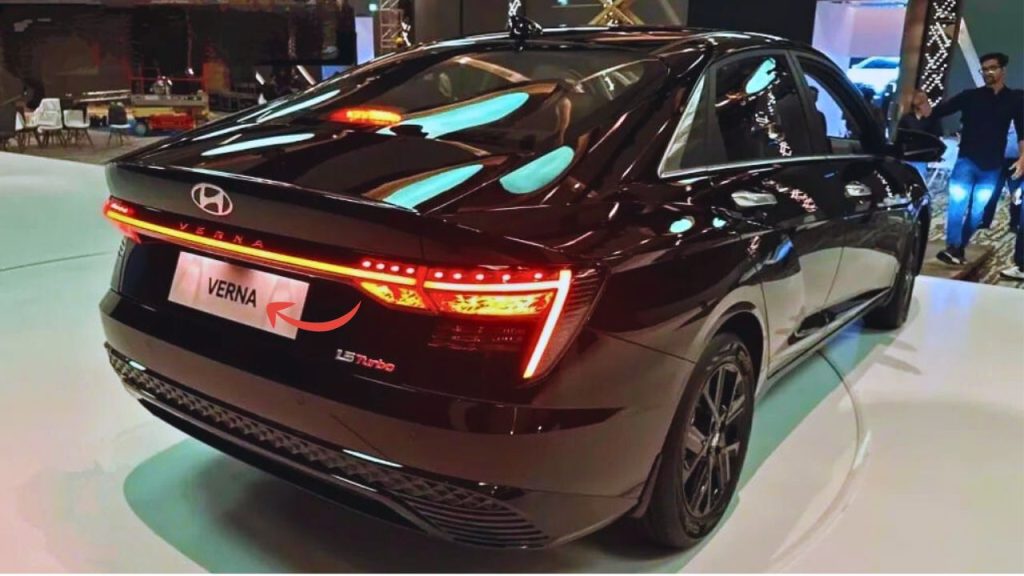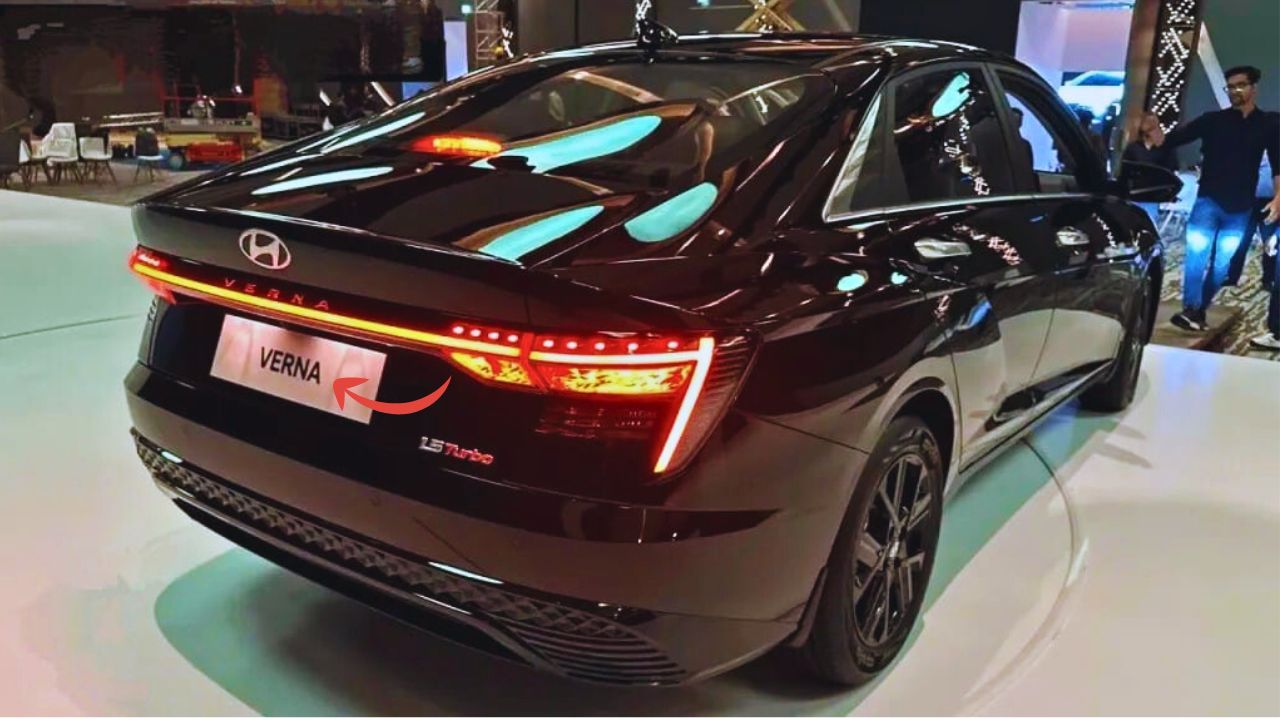In a strategic move that has sent ripples through the competitive midsize sedan market, Hyundai has unveiled a new variant of its popular Verna model. This launch comes at a crucial time when consumer preferences are evolving rapidly and competitors are aggressively upgrading their offerings. The latest iteration of the Verna is not merely an incremental update but represents Hyundai’s bold statement of intent to dominate this fiercely contested segment.

A Fresh Design Language That Turns Heads
The new Hyundai Verna variant immediately distinguishes itself with a design philosophy that balances aggression with sophistication. The front fascia features an enlarged parametric jewel grille that stretches across the width of the vehicle, flanked by slim LED headlamps with distinctive daytime running lights that create an unmistakable light signature. This design element alone makes the new Verna instantly recognizable on roads increasingly populated by lookalike sedans.
Moving along the side profile, the strong character line that runs from the front fender to the wraparound tail lamps creates a sense of motion even when the car is stationary. The coupe-like sloping roofline – a departure from the more conventional three-box design of previous generations – gives the new variant a sportier stance without compromising on rear headroom, a clever engineering feat that addresses a common complaint with sporty sedan designs.
The rear section completes the visual drama with connected LED tail lamps featuring pixel-inspired elements that echo the digital theme present throughout the vehicle. The subtle trunk lip spoiler and dual-tone bumper with diffuser-like elements further enhance the athletic appearance. Compared to rivals like the Honda City, Maruti Suzuki Ciaz, and Volkswagen Virtus, the new Verna variant projects a more youthful and dynamic personality.
Cabin Experience: Where Technology Meets Comfort
Step inside the new Verna variant, and you’re greeted by an interior that represents a significant leap forward in terms of both design and technology implementation. The minimalist dashboard layout centers around a panoramic display setup, combining a 10.25-inch digital instrument cluster with a similarly sized touchscreen infotainment system under a single glass panel. This arrangement, previously seen only in vehicles from premium segments, brings a distinctly upmarket feel to the cabin.
The materials used throughout the interior show Hyundai’s commitment to elevating the in-cabin experience. Soft-touch materials on frequently touched surfaces, leatherette upholstery with contrast stitching, and brushed aluminum-finish trim pieces create an ambiance that belies the vehicle’s price point. Attention to detail is evident in elements like the knurled finish on control knobs and the damped movement of storage compartment lids.
Practicality hasn’t been sacrificed at the altar of style, with the new variant offering increased rear legroom – a crucial factor in the Indian market where many owners prefer to be chauffeured. The rear seats now feature a more comfortable recline angle and improved thigh support, addressing feedback from existing Verna customers. Ventilated front seats, a feature pioneered by Hyundai in this segment, have been retained and improved with faster cooling performance.
Powertrains: Performance and Efficiency in Perfect Balance
The headline feature of the new Verna variant is undoubtedly its powertrain options. Hyundai has introduced a new 1.5-liter turbocharged gasoline direct injection (T-GDi) engine that produces an impressive 160 horsepower and 253 Nm of torque – figures that establish it as the most powerful offering in its segment. This engine can be paired with either a six-speed manual transmission for driving enthusiasts or a seven-speed dual-clutch transmission (DCT) for those who prefer effortless shifts.
For buyers who prioritize fuel efficiency, the new variant continues to offer the reliable 1.5-liter naturally aspirated petrol engine with 115 horsepower, available with either a six-speed manual or an intelligent variable transmission (IVT). The IVT-equipped version delivers a claimed fuel efficiency of approximately 19.5 km/l under ideal conditions – a figure that challenges even some smaller hatchbacks.
What distinguishes the new Verna’s powertrains from competitors is not just raw performance numbers but the refinement of the entire driving experience. The turbo engine delivers power in a linear fashion without the sudden surge that can make some turbocharged cars difficult to drive smoothly in urban conditions. The engine sound insulation has been improved significantly, resulting in a cabin that remains remarkably quiet even when the engine is pushed hard.
Advanced Technology: Bringing Premium Features to the Mainstream
Hyundai has traditionally been a pioneer in democratizing technology, and the new Verna variant continues this tradition by introducing several segment-first features. The comprehensive ADAS (Advanced Driver Assistance Systems) suite includes features like lane keeping assist, forward collision warning, blind-spot monitoring, and adaptive cruise control – technologies typically associated with vehicles from much higher price segments.
The connectivity features have received a major upgrade with an improved version of Hyundai’s BlueLink connected car technology. This system now offers over 60 connected features, including remote engine start/stop, climate control operation, vehicle tracking, and geofencing alerts. The integration with smartphones has been enhanced, with support for multiple user profiles and personalized settings that can be transferred between different Hyundai vehicles.
The infotainment system features wireless Android Auto and Apple CarPlay, an 8-speaker Bose premium sound system tuned specifically for the Verna’s cabin acoustics, and natural language voice recognition that can understand contextual commands. The system can receive over-the-air updates, ensuring that the technology remains current throughout the ownership period – a significant advantage over competitors whose infotainment systems become increasingly outdated with time.
Chassis Dynamics: Engineered for Indian Conditions
Beyond the flashy design and technology features, Hyundai has made significant improvements to the Verna’s underlying chassis and suspension setup. The new variant utilizes an enhanced version of the K2 platform with increased use of high-strength steel, resulting in improved torsional rigidity without adding excessive weight. This structural improvement translates to better handling characteristics and enhanced crash protection.
The suspension tuning represents perhaps the most carefully considered aspect of the new variant’s development. Previous Verna generations were occasionally criticized for prioritizing comfort over handling, resulting in a somewhat floaty feel at highway speeds. The new variant addresses this with a more sophisticated multi-link rear suspension (replacing the torsion beam setup in lower variants) and retuned dampers that strike an excellent balance between ride comfort and body control.
The steering system has been recalibrated to offer more feedback without becoming unnecessarily heavy in urban driving conditions. The variable-assist electric power steering adjusts weight based on driving speed, providing light steering for parking maneuvers and progressively firmer response as speed increases. This nuanced approach to steering feel addresses a common complaint about earlier Hyundai models and brings the driving experience closer to European rivals like the Volkswagen Virtus.
Safety: Building Confidence Through Engineering
Safety has become an increasingly important consideration for Indian car buyers, and Hyundai has responded by making the new Verna variant one of the safest offerings in its segment. The enhanced body structure utilizes a higher percentage of advanced high-strength steel, creating a rigid safety cage around the occupants.
Standard safety equipment across the range includes six airbags, electronic stability control, vehicle stability management, hill-start assist, and ISOFIX child seat anchors. Higher trim levels add the previously mentioned ADAS features, a 360-degree camera system with blind view monitor (which displays the blind spot camera feed in the instrument cluster when the turn signal is activated), and an electronic parking brake with auto-hold function.
Hyundai has not yet subjected the new variant to Global NCAP crash testing, but the company has expressed confidence that it will achieve a high safety rating when evaluated. This focus on safety features, both passive and active, positions the new Verna variant as a compelling option for family buyers who prioritize protection for their loved ones.
Customization Options: Personalizing the Experience
Recognizing that modern consumers value the ability to personalize their vehicles, Hyundai has introduced an expanded range of customization options with the new Verna variant. The color palette has been expanded to include several new options, including dual-tone combinations with a contrast black roof on select trims. Interior color themes can be selected based on the exterior color choice, allowing for a more cohesive aesthetic.
Beyond cosmetic options, buyers can select from various accessory packages that bundle together features based on specific usage patterns. The Tech Pack adds additional technology features, while the Comfort Pack enhances the luxury quotient with additions like a sunroof, ambient lighting, and premium upholstery. The Sport Pack focuses on visual enhancements with body kits, alloy wheel upgrades, and interior trim pieces with a more dynamic appearance.
This approach to customization allows buyers to tailor their Verna to specific preferences without having to step up to a higher trim level just for one or two desired features – a flexibility that most competitors don’t offer.
Ownership Experience: Beyond the Product
Hyundai’s approach to the new Verna variant extends beyond the physical product to encompass the entire ownership experience. The warranty package has been enhanced to include a standard 3-year/unlimited kilometer coverage, with options to extend to 5 or even 7 years. The maintenance packages have been designed to provide transparent ownership costs, with options for prepaid maintenance plans that protect against future price increases.
The service network, already one of the most extensive among premium automobile brands in the country, has been further strengthened with additional facilities and improved service processes that reduce waiting times. The Hyundai service app has been upgraded to provide real-time status updates during servicing, online appointment booking, and maintenance history tracking.
Market Positioning: Value Proposition That Challenges Segments Above
The pricing strategy for the new Verna variant reveals Hyundai’s confidence in the product and its value proposition. While maintaining competitive pricing against direct rivals like the Honda City and Maruti Ciaz, the top-end variants with their premium features and powerful turbocharged engine are positioned to attract buyers considering entry-level models from luxury brands or crossover SUVs.
This strategic positioning acknowledges that modern car buying decisions are increasingly based on features and emotional appeal rather than rigid segment boundaries. By offering near-luxury features in a mainstream sedan package, Hyundai is creating a compelling alternative for buyers who might otherwise stretch their budget for a luxury badge or follow the crossover trend.
Redefining Expectations in the Sedan Segment
The launch of the new Hyundai Verna variant comes at a critical juncture for the sedan market in general. While crossovers and SUVs have been gaining market share, there remains a significant customer base that appreciates the driving dynamics, efficiency, and elegance of a well-designed sedan. With this new variant, Hyundai is not merely defending its position in the sedan segment but is actively working to revitalize interest in this body style.
By combining striking design, advanced technology, capable powertrains, and thoughtful features in a comprehensive package, the new Verna variant makes a compelling case for the continued relevance of sedans in today’s automotive landscape. It challenges competitors to raise their game while simultaneously reaching up to pressure vehicles from premium segments.
For consumers, this translates to exceptional value – a vehicle that delivers experiences previously available only at much higher price points. As the automotive market continues to evolve, the new Hyundai Verna variant stands as proof that with the right combination of innovation, design, and value, the sedan body style still has much to offer to discerning car buyers.
Also read: Yamaha RX 125, Return of the Legend, The Two-Stroke Revolution Nobody Expected – hdtc.co.in
